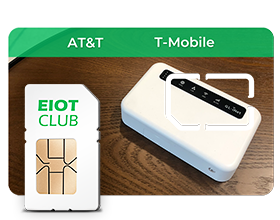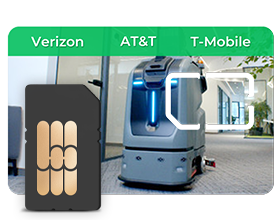The Role of 5G SIM Cards in Security Cameras

In today’s world, security cameras have essentially become household essentials, making it crucial to access live video streams anytime, anywhere. Whether monitoring remote properties or ensuring family safety, traditional Wi-Fi connections often suffer from unexpected disruptions. This is where SIM cards come in: they provide cameras with highly stable network connectivity. No matter where you move or what data plan you need, they keep your system connected. But how exactly do SIM cards work? Can they really improve video quality? This article takes a deep dive into the core of “5G SIM Card for Camera,” explaining its true capabilities and guiding you on how to get the most out of your “Security Camera 5G SIM Card.”
1. Key factors that determine image quality
(1) Clarity of the camera's "eye" (resolution)
Just like a mobile phone camera, the clarity of a camera is determined by its sensor. A 1080P camera can only produce 1080P images at most; it cannot "become" 4K out of thin air. The higher the resolution, the more details there are, but the larger the generated video file is, and the higher the network requirements are.
The following are the common types of resolution: standard definition (SD), high definition (HD/720p), full high definition (FHD/1080p), 2K, 4K, and higher-end 8K and 10K. These resolutions represent the increase in the number of pixels from low to high, providing different visual experiences from basic image quality to extreme clarity. Among them, 1080p, 2K and 4K are the mainstream resolutions on the market.
(2) Video compression and bit rate (video size)
The camera will not directly transmit the "original picture" because the data would be too large. It uses video compression technology similar to H.264 or H.265 to "pack and reduce" the video. The key here is the bit rate:
High bit rate → More video details and clearer images, but requires a faster network;
Low bit rate → Smaller files and less traffic for transmission, but the images are prone to blur and mosaics.
So manufacturers usually make a balance: ensuring clarity while controlling file size.
(3) Lens and night vision function
Lens quality determines whether the image is clear and whether there is distortion.Night vision function (infrared fill light, low light technology) determines whether you can see clearly at night. For example: during the day, everything looks the same, but at night, the difference between a good lens and an ordinary lens can be seen at a glance. The night vision effect of a good camera is almost the same as that during the day.
2.The impact of storage methods on image quality
(1) Local storage (SD card)
If the camera directly stores the video on its own SD card, it will generally save the "highest definition" image because it does not need to consider the network speed. This way the video quality is stable, but be aware that if the camera is damaged or the SD card is full, the video may be lost. So there is a certain risk
(2) Cloud storage (upload to server)
If your video needs to be uploaded to the cloud, the image quality depends not only on the camera, but also on the network:
Fast network → can upload higher definition video;
Slow network → can only compress the video smaller, which looks not as clear.
So many solutions will adopt "double insurance":
Save a high-definition video locally;
At the same time, upload a lower definition but sufficient version to the cloud.
This allows remote viewing at any time and ensures a high-quality local backup at critical moments.
In a nutshell: the quality of the image depends first on the camera itself (resolution, lens, night vision), and secondly on how it is stored and transmitted. The purpose of a SIM card is to ensure that your video can be transmitted smoothly, but if the camera itself is not powerful, the image quality will not be improved even if the network is fast.
3. The actual impact of the network on image quality
When a video is transmitted from a camera to a mobile phone or the cloud, the network is the "highway". The quality of this road directly determines whether you can see a clear picture smoothly.
(1) Bandwidth size = highway width
Bandwidth is like the number of lanes on a highway. High-definition video requires "large lanes" to run smoothly:
Enough bandwidth → the video can use a higher bit rate and the picture is clearer;
Insufficient bandwidth → the camera can only compress the video to a small size, and the clarity is reduced.
For example, 4K images require more than twice the bandwidth of 1080P. If the bandwidth is insufficient, the clarity will be automatically reduced.
(2) Latency and packet loss = traffic jams or dropped packages
When the network is unstable, it is like a sudden traffic jam on the highway or a dropped package:
High latency → the picture will be jerky and seem to be stuck;
Severe packet loss → mosaics and distorted images will appear on the screen.
Even if the camera can capture clear pictures, these problems will make the picture quality look poor.
(3) Adaptive Adjustment = Automatic Lane Change
To cope with unstable networks, many cameras support "bitrate adaptation." That is, if the network suddenly deteriorates, it will automatically reduce the clarity to ensure that the image can continue to be transmitted, rather than directly interrupting it. Although this can keep the video continuous, the clarity will be reduced.
The network is the "highway" for video transmission. The bandwidth determines how clear it can be, and the stability determines whether it can be smooth. The role of the SIM card is to provide your camera with a dedicated, always-available "highway." This is why using a SIM card allows the camera to stay connected to the Internet anytime, anywhere in places without Wi-Fi.
The Actual Function of a SIM Card: What It Is and What It Isn't?
Let's clarify this in one sentence:
The SIM card's purpose is to connect your camera to the internet and be recognized by the network, sending your camera's video to the cloud or to your phone. It doesn't determine image quality, doesn't determine lens quality, and doesn't magically turn 1080p into 4K. Image quality depends entirely on the camera, so a good camera plays a primary role in image quality.
1) What a SIM Card Really Does (Core Function)
Giving your camera "network access"—the SIM card acts as your camera's ID card on the carrier's (AT&T, T-Mobile, etc.) network. It connects to 3G/4G/5G mobile networks and transmits video data from the front-end. This is the fundamental value of the "5G SIM Card for Cameras / Security Cameras 5G SIM Card": anytime, anywhere connectivity, independent of on-site broadband and Wi-Fi.
Complete network authentication and billing.
The SIM/eSIM proves to the carrier that this device is legitimate and can use this plan. It also determines your data plan, roaming, network policy (APN), and more. For enterprises or campuses, dedicated APNs/private 5G can also be used for more stable access.
Provide mobility and coverage redundancy.
This allows for plug-and-play operation in locations without fixed broadband (such as construction sites, temporary buildings, remote farms, parking lots, temporary events, and mobile carriers). It can also serve as a backup for wired networks in cities (automatically switching to 4G/5G if the primary network is down). Industry research lists "camera-based campus security" as one of the top use cases for private 5G.
2) What SIM cards can't do (don't misunderstand it):
Can't improve "native image quality."
Resolution, lens, night vision (infrared/starlight), wide dynamic range (WDR), noise reduction, and more are all determined by the camera's hardware and algorithms; a SIM card can't change this "source image quality."
Frame rate/compression details cannot be determined.
Whether to use 30fps or 15fps, H.264 or the more efficient H.265, and the bitrate are all compressed within the camera. H.265 typically uses 25%–50% less bandwidth than H.264, a result of long-standing consensus in encoding standards and vendor white papers.
To use an analogy:
The SIM card is a "highway" that transports the video fleet; the quality of the vehicle (image quality) is determined by the camera, while its speed (clarity/fluidity) depends on whether the road is congested (bandwidth/signal).
3) Why is 5G more camera-friendly?
When watching videos, we're used to talking about "downloading," but cameras are uploading. Industry research repeatedly emphasizes that uplink bandwidth is critical to the real-time video experience. For example, stable and high-quality mobile video conferencing often requires a sustained uplink of 4 Mbps or higher; cameras also rely on robust uplinks to deliver high-definition streams. Compared to 4G, 5G is better positioned to deliver higher uplink speeds and more stable latency through its cell design, scheduling, and slicing mechanisms.
Large Connectivity & Greater Reliability
5G's advantages aren't just about speed; they also include the ability to connect more devices at the same site, more controllable latency, and greater reliability, which are crucial for high-density campuses and campus-level camera networks. Reports such as the GSMA indicate that 5G's capacity and slicing can support a large number of streaming video devices.
The Rise of Private 5G Use Cases
Private 5G (self-built or hosted in campuses, schools, or factories) often lists security cameras as a key use case: unified coverage, stable uplinks, and local backhaul/edge storage make it ideal for concurrent use of multiple cameras.
4) How do you balance the key concern of "resolution vs. data costs"?
Bitrate = The "knob" for clarity and bandwidth.
For the same 1080P camera, 2.5–5 Mbps with H.265 provides good viewing quality (according to industry knowledge and manufacturer experience); H.264 generally requires higher bitrates. Higher bitrates improve clarity, but also increase bandwidth consumption.
Here's a rough estimate (understand in ten seconds):
Using 2 Mbps as an example:
Approximately 0.9 GB per hour → approximately 21.6 GB in 24 hours → approximately 648 GB in 30 days.
Switching to 5 Mbps: The bandwidth becomes approximately 2.25 GB/hour, 54 GB/day, and 1.6 TB/month.
If you want "remote viewing at any time and control your data costs," we recommend: local high-bitrate recording (SD/NVR) + cloud/mobile sub-stream (lower bitrate) viewing. This is also the approach recommended in white papers by leading manufacturers (strategies such as intelligent bitrate, Zipstream, and dynamic GOP).
5) Industry Report Consensus (Simplified and Condensed Version)
Video-based IoT is a significant beneficiary of 5G: 5G's capacity and concurrency are clearly beneficial for large-scale video surveillance scenarios, especially in campus/city-level deployments.
Uplink is a key bottleneck: The real-time video experience often suffers from insufficient uplink coverage and speed. 5G's TDD configuration, site deployment, and slicing can improve the upload experience.
Private 5G is making "5G on cameras" a mainstream use case: factories, campuses, and shopping malls are prioritizing video surveillance as a priority use case for private networks.
IoT Analysis
High-efficiency encoding methods like H.265 combined with intelligent bitrates strike a balance between cost and experience: significantly reducing bandwidth and cloud storage costs while maintaining the same visual quality, they are the foundation for sustainable cloud surveillance.
Security and governance still require attention: 5G/IoT introduces more device access and increased responsibility boundaries, necessitating the implementation of security and privacy governance (APN/VPN, certificates, and platform-side compliance) on both the network and device sides.
6) A practical checklist for selecting a "Security Camera 5G SIM Card" (the simpler, the less pitfalls)
Coverage: Choose the carrier with the most stable signal at the installation location; if moving across cities or countries, prioritize multi-network/roaming-friendly SIM cards.
Package and Uplink: Check for peak uplink speeds, speed limits, and speed reductions upon reaching a certain limit; avoid "short video/mobile" plans for extended live streaming. Reference requirements: 1080P with a typical speed of 2.5–5 Mbps (H.265).
APN/Access Method: If you prefer point-to-point/backend connections over direct cloud connections, you'll need a dedicated APN/static public IP or VPN. Many IoT cards default to CGNAT, preventing calls from the outside world—check this in advance.
4G Compatibility: The camera will fall back to 4G in areas with weak 5G. Ensure an acceptable 4G experience and confirm that the device supports the local carrier's frequency bands.
Security: Use strong passwords/certificates, and enable device permissions and logging on the platform. For enterprise scenarios, private network/VPN isolation is recommended.
Strategy: Enable the camera's intelligent bitrate/dynamic GOP/event-triggered recording: "Clear transmission" when in motion, "saving data" when inactive.
Summary (3 words for decision makers)
SIM card = connectivity: Solve the "view anywhere" problem; 5G enables "more stable and faster uploads," making it particularly suitable for multi-channel concurrent access and high-density campuses.
Image quality = the camera itself: Clarity depends on the lens/sensor/algorithm; the SIM card does not create image quality, it only transports it.
Cost = bitrate and strategy: Use a dual-track solution combining H.265 + intelligent bitrate and "local HD, cloud-based low bitrate" for clear viewing and cost savings.
Potential Indirect Impacts: How the Network Affects Perceived Image Quality
While the SIM card itself doesn't create image quality, the quality of the mobile network it relies on directly determines how clear and smooth the surveillance footage you see on your phone or computer is. This is why choosing the right 5G SIM card for cameras is equally important for home and business users.
1. Network-Related Impacts
Low Signal Strength
When a camera is in an area with weak signal strength, upload speeds will drop significantly. To ensure continuous video streaming, the camera or cloud platform will automatically reduce the bitrate, resulting in blurry, pixelated, or blurred video. This is particularly frustrating when you need to clearly see license plates and facial details.
Data Caps
Many carriers have data caps on their plans. Once you exceed this limit, the carrier will reduce your network speed (commonly known as "throttling"). Even high-end cameras will have to reduce image quality to accommodate limited bandwidth. Therefore, if you plan to monitor your camera 24/7 for extended periods of time, choosing a 5G SIM card with the right data capacity is crucial. High Latency
High latency means it takes longer for video to transmit from the camera to your phone, resulting in lags in the live feed and even audio and video syncing. For door intercom cameras designed to communicate with visitors in real time, this latency can significantly impact the user experience.
2. Carrier-Related Restrictions
Resolution Cap
Some older or lower-priced plans limit the resolution of the video stream behind the scenes. For example, some plans only allow for 720p video transmission. Even if your camera supports 1080p or 4K, the image transmitted to your phone will still be "downscaled." This is why, when choosing a 5G SIM card for cameras, it's important to check whether the plan supports HD video or has no resolution restrictions.
Peak Bandwidth Management
During periods of network congestion, such as evening rush hour or weekends, carriers may prioritize bandwidth. If your camera is assigned a lower priority, your camera's video upload speed will decrease, resulting in a less smooth remote viewing experience. This is particularly common in urban areas where network resources are shared.
Summary: Network is the "invisible variable that determines the user experience."
The camera's hardware determines the clarity of the images, but the network determines whether you can see that clarity in real time.
Choosing a high-quality 5G SIM card for camera not only keeps your camera online anytime, anywhere, but also reduces the indirect impact of signal quality issues, speed limits, and latency, making the remote monitoring experience more reliable.
| Resolution & Frame Rate | Recommended Upload Bandwidth (H.265) | Approx. Data per Hour | Approx. Data per Month (24/7) | Typical Use Case | Suggested Plan |
| 720p @ 15fps | ~1 Mbps | ~0.45 GB | ~324 GB | Basic monitoring, pets | Small data plan |
| 1080p @ 25fps | ~2–3 Mbps | ~1.0 GB | ~720 GB | Front door, retail shop | Medium-to-high data plan, ideally 1TB/month or more |
| 2K (1440p) @ 25fps | ~4 Mbps | ~1.8 GB | ~1.3 TB | License plate, detail monitoring | High data plan, 2TB/month or more |
| 4K @ 30fps | ~8–10 Mbps | ~3.6 GB | ~2.6 TB | Enterprise, premium surveillance | Unlimited plan or dedicated Security Camera 5G SIM Card |
Optimization Strategies: How to Choose and Configure the Best 5G SIM Card for Your Security Camera
Once you understand how video quality and networks interact, you can make smarter choices about which 5G SIM Card for Camera to buy and how to configure your system. These steps ensure your security camera delivers smooth, clear video whenever you need it.
1. Choosing the Right SIM Card
Coverage Comes First
Don’t just chase the “5G” logo. A reliable signal is far more important than the brand name. Check which carrier (Eiotclub,AT&T, T-Mobile, Verizon in the U.S.) offers the strongest coverage at your camera’s location. A stable 4G LTE signal is better than weak or spotty 5G.
Go 5G for High-Bitrate Cameras
If you’re running 4K or high-frame-rate cameras, the data load can be massive. A true 5G SIM Card for Camera, such as the Eiotclub 5G SIM Card for Security Camera, provides the higher upload speeds and lower latency you need. This prevents network bottlenecks and ensures your premium equipment performs at its best.
Mind the Data Plan
Choose a plan with generous or unlimited data. Pay attention to “Fair Use” or throttling policies. If your camera runs 24/7, you don’t want the video feed downgraded mid-month because you hit a cap. An unlimited or IoT-specific Security Camera 5G SIM Card is often the safest choice.
2. Camera Configuration Tips
Enable Adaptive Bitrate
If your camera supports it, turn on adaptive streaming. This allows the camera to automatically adjust video quality based on signal strength—full HD when the connection is strong, smooth but lower resolution when the signal is weaker. This keeps your feed online without interruptions.
Use Local Storage as Backup
Always insert a high-quality SD card. Set recording o “dual mode”: local + cloud, or at least “event-based local storage + continuous cloud stream.” That way, even if your network drops, you still have critical evidence saved locally.
Schedule Smart Updates
Set firmware updates to run during off-peak hours (like 2–4 AM). This ensures your camera isn’t wasting live-stream bandwidth on background downloads when you need real-time video.
Picking the right 5G SIM Card for Camera is about more than just speed. It’s about coverage, data plan flexibility, and matching the SIM card to your camera’s performance needs. Combine that with smart configuration—adaptive bitrate, local backup, and scheduled updates—and your Security Camera 5G SIM Card setup will be reliable, secure, and cost-effective.

























 Black Friday
Black Friday






